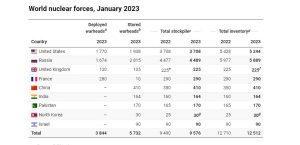The Stockholm International Peace Research Institute (SIPRI) has released its annual evaluation of armaments, disarmament, and international security, highlighting significant developments in the global nuclear landscape. The findings of the SIPRI Yearbook 2023 emphasize the increase in operational nuclear weapons as countries pursue long-term plans for modernization and expansion.
As of January 2023, the estimated global inventory of warheads stands at 12,512, with approximately 9,576 warheads being held in military stockpiles for potential use.
Among the nine nuclear-armed states, including the United States, Russia, the United Kingdom, France, China, India, Pakistan, North Korea, and Israel, there is an ongoing trend of nuclear arsenal modernization and the deployment of new nuclear-armed or nuclear-capable weapon systems. In 2022, several nations made strides in this regard.
Out of these warheads, approximately 3,844 are deployed with missiles and aircraft, while around 2,000 warheads, primarily belonging to Russia and the USA, are in a state of high operational alert.
As of January 2023, the estimated global inventory of warheads stands at 12,512, with approximately 9,576 warheads being held in military stockpiles for potential use. This represents an increase of 86 warheads compared to January 2022. Out of these warheads, approximately 3,844 are deployed with missiles and aircraft, while around 2,000 warheads, primarily belonging to Russia and the USA, are in a state of high operational alert.
Russia and the USA remain the dominant players in the nuclear arena, possessing nearly 90% of all nuclear weapons. Although the sizes of their respective arsenals have remained relatively stable in 2022, transparency regarding nuclear forces has declined due to Russia’s invasion of Ukraine in February 2022.
China’s nuclear arsenal has experienced a significant expansion, with SIPRI estimating its size to have increased from 350 warheads in January 2022 to 410 in January 2023. This upward trend is expected to continue, potentially placing China on par with or surpassing the number of intercontinental ballistic missiles (ICBMs) possessed by the USA or Russia by the end of the decade.
This development raises concerns as it contradicts China’s stated objective of maintaining a minimum nuclear force for national security purposes.

While the UK’s nuclear weapon arsenal is believed to have remained unchanged in 2022, the stockpile is projected to grow in the future due to the British government’s decision to raise the limit from 225 to 260 warheads. However, the government has chosen not to disclose this information publicly.
France pursued various programs in 2022, focusing on the development of a third-generation nuclear-powered ballistic missile submarine (SSBN) and a new air-launched cruise missile, alongside refurbishment and upgrading of existing systems.
India and Pakistan are expanding their nuclear arsenals and continuing the development of new nuclear delivery systems. India appears to be placing increased emphasis on longer-range weapons capable of reaching targets in China, while Pakistan remains the main focus of India’s nuclear deterrent.
North Korea remains committed to its military nuclear program as a key component of its national security strategy. Although no nuclear test explosions were conducted in 2022, the country carried out over 90 missile tests, some of which may have the capability to carry nuclear warheads. SIPRI estimates that North Korea now possesses around 30 warheads and has sufficient fissile material to produce 50-70 warheads, marking significant increases compared to January 2022.
Israel, while not publicly acknowledging its possession of nuclear weapons, is believed to be engaged in modernizing its nuclear arsenal.
The realm of nuclear arms control and disarmament diplomacy has faced setbacks due to Russia’s invasion of Ukraine in February 2022.
The USA suspended its bilateral strategic stability dialogue with Russia, and Russia subsequently announced its suspension of participation in the 2010 Treaty on Measures for the Further Reduction and Limitation of Strategic Offensive Arms (New START), the remaining nuclear arms control treaty between Russia and the USA.




